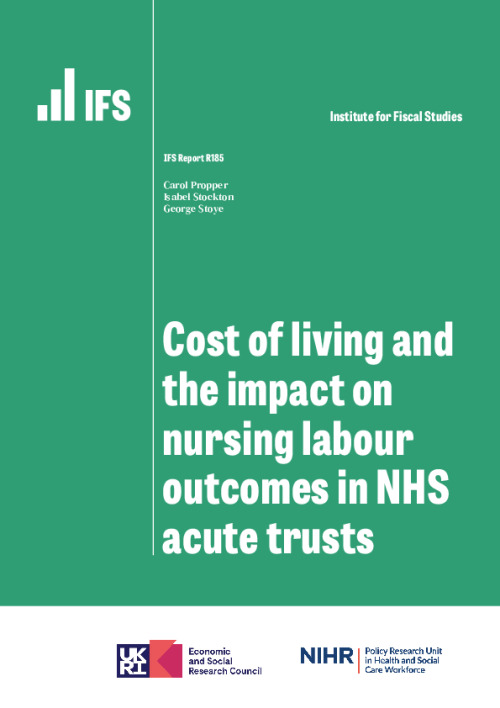Retention of nursing staff within the NHS is a key policy issue. Pay policy – and the ability that trusts and nurses have to react to local working conditions and the cost of living – is likely to be a key lever in reducing attrition among current staff. Understanding the restrictions that the current system places on trusts in the face of local cost-of-living changes, and the responses of staff to the decisions made by these trusts, is therefore important in improving staff retention.
Pay for the majority of nurses is determined by national guidelines on basic salary. This ensures that basic pay is the same across different trusts, and reduces wage competition between hospitals who could potentially compete for the same members of staff. Additional pay is available through geographical allowances in order to compensate nurses who live in areas with higher costs of living. Trusts also have some discretion in the use of other additional allowances depending on their local labour market conditions and their own finances. However, even with these additional payments, pay for similar roles across areas varies substantially less than the cost of living in these areas. As a result, the relative value of pay for nurses in lower-cost areas remains considerably higher than for those living in more expensive areas.
This report examines the effect that variation in the cost of living has on the labour supply of existing nurses in NHS acute trusts. We focus on Band 5 and 6 nurses. These accounted for 23% of the workforce in NHS acute trusts in 2018. We use administrative payroll data from the Electronic Staff Record (ESR) to examine how trusts and nurses react to changes in the local cost of living, and the impact these changes have on the amount of labour supplied by existing nurses.
Our analysis uses local house prices, measured at the travel-to-work-area level, as a proxy for the local cost of living. This is due to the unavailability of consistent data on price series, such as the Consumer Prices Index (CPI), at a local level. Housing costs represent a large share of living costs for nurses, and as such provide a good measure for their wider cost of living. The baseline results use the price for a terraced house, but are robust to using other local house price series.
We first describe how the earnings, hours and composition of nurses vary across the country. These labour market outcomes may vary as a result of differences in the cost of living. But they will also be driven by a number of factors that are related to, but not caused by, differences in the cost of living across areas, such as the amenity of the area and the opportunities offered in different types of hospitals. Our main analysis therefore examines how changes in the cost of living, as measured by changes in house prices in the local area, are related to changes in nurses’ labour supply. These in turn will lead to long-run differences in labour recruitment and retention across different areas.
Key findings
- Despite pay regulation, annual earnings for nurses in the same role vary across the country. Basic earnings of nurses are governed by national pay scales, determined under Agenda for Change, which do not vary across the country. In recognition of potential staff shortages, trusts have some additional flexibility in using supplements to basic pay. The use of these supplements varies considerably across trusts.
- This variation in pay is dwarfed by much larger differences in the cost of living. Average house prices range from 2.5 to 14 times the average nurse earnings in the local area. This indicates that the relative value of nurse earnings varies considerably across the country.
- Trusts respond to these cost-of-living differences through several channels. These include offering extra hours of work to those who are not already full time, offering bank work and faster promotion if vacancies exist. Nurses can then choose to work additional hours, accept promotions or leave the trust (either to move to another trust or to leave the NHS acute sector entirely).
- Increases in the cost of living lead to an increase in the earnings of nurses in the local area as a result of these trust and nurse responses. Much of this increase in pay is explained by an increased rate of promotion to higher bands (which in part may be required to fill any vacancies created by more senior nurses leaving as a result of the growth in cost of living), and therefore to a higher salary. Trusts also increase the amount paid in supplementary allowances, although these account for a relatively small share of average earnings (15% in 2018).
- However, nurses work fewer hours for NHS acute trusts in response to an increase in the cost of living. The number of non-bank hours falls in response to an increase in house prices. The likelihood of working any bank hours and, conditional on doing so, the earnings from bank work are also reduced.
- Responses vary across pay bands. Band 5 nurses work more in response to an increase in the cost of living, while Band 6 nurses work less.
- A higher cost of living leads to an increased exit rate from the NHS acute trust sector and an increased rate of job changes between trusts. The median three-year increase in house prices of 13.9% between 2011 and 2017 resulted in a 1.8 percentage point increase in nurses leaving the NHS acute trust sector and a 2.4 percentage point increase in nurses switching between NHS acute trusts. These increases are equivalent to 11% and 22% of the mean exit and switching rates respectively.
- Nurses in permanently high-cost areas also experience larger increases in earnings and in the probability of promotion than nurses in lower-cost areas.
- There are differences in the reaction of nurses across different groups. Younger nurses are more responsive to cost-of-living increases than their older peers. Part-time nurses respond to shocks by working more, while full-time nurses work less.
- There is little difference in the reactions of nurses of different nationalities. British and non-British nurses are both more likely to leave or switch trusts, and more likely to be promoted, as a result of an increase in the cost of living.
- In sum, our report provides evidence that the existing national pay system does not provide trusts with sufficient flexibility to retain staff in the face of cost-of-living increases. Trusts located in areas that have a long-run high cost of living face particular difficulties.













